A Circular Sector-Shaped Dipole Antenna with Meandered Arms and Added Ferrite-Loaded Artificial Magnetic Conductor
Abstract
:1. Introduction
2. The AMC and Antenna Designs
2.1. Design of AMC Structure
2.2. Design of Circular Sector-Shaped Dipole Antenna with Meandered Arm
2.3. The Proposed Circular Sector-Shaped Dipole Antenna with AMC
3. Designed Antenna Performance
4. Experimental Results
5. Conclusions
Author Contributions
Funding
Institutional Review Board Statement
Informed Consent Statement
Data Availability Statement
Conflicts of Interest
References
- Mi, S.; Lee, Y.H.; Shen, Z. Ferrite Coating Design for Near-Ground HF Bowtie Antenna. IEEE Trans. Antennas Propag. 2017, 65, 2074–2078. [Google Scholar] [CrossRef]
- Bouvy, A.; Behdad, N. A Heuristic Study of the Bandwidth Potential of Electrically Small, Platform-Based Antennas at the HF Band. IEEE Trans. Antennas Propag. 2021, 69, 623–635. [Google Scholar] [CrossRef]
- Garrido Lopez, D.; Ignatenko, M.; Filipovic, D.S. Low-Profile Tri-band Inverted-F Antenna for Vehicular Applications in HF and VHF Bands. IEEE Trans. Antennas Propag. 2015, 63, 4632–4639. [Google Scholar] [CrossRef]
- Best, S.R.; Hanna, D.L. A Performance Comparison of Fundamental Small-Antenna Designs. IEEE Antennas Propag. Mag. 2010, 52, 47–70. [Google Scholar] [CrossRef]
- Baker, J.M.; Iskander, M.F. A New Design Approach for Electrically Small High-Frequency Antennas. IEEE Antennas Wirel. Propag. Lett. 2015, 14, 402–405. [Google Scholar] [CrossRef]
- SaiRam, C.; Vakula, D.; Chakravarthy, M. Design of Broadband Compact Canonical Triple-Sleeve Antenna Operating in UHF Band. J. Electromagn. Eng. Sci. 2021, 21, 291–298. [Google Scholar] [CrossRef]
- Sievenpiper, D.F.; Dawson, D.C.; Jacob, M.M.; Kanar, T.; Kim, S.; Long, J.; Quarfoth, R.G. A compact filtering microstrip antenna with quasi-elliptic broadside antenna gain response. IEEE Trans. Antennas Propag. 2012, 60, 8–19. [Google Scholar] [CrossRef]
- Gunamony, S.L.; Gnanadhas, J.B.; Lawrence, D.E. Design and Investigation of a Miniaturized Single-Layer ACS-Fed Dual Band Antenna for LTE and 5G Applications. J. Electromagn. Eng. Sci. 2020, 20, 213–220. [Google Scholar] [CrossRef]
- Jin, P.; Lin, C.; Ziolkowski, R.W. Multifunctional, Electrically Small, Planar Near-Field Resonant Parasitic Antennas. IEEE Antennas Wirel. Propag. Lett. 2012, 11, 200–204. [Google Scholar]
- Choi, Y.-S.; Hong, J.-H.; Woo, J.-M. Electrically and Frequency-Tunable Printed Inverted-F Antenna with a Perturbed Parasitic Element. J. Electromagn. Eng. Sci. 2020, 20, 164–168. [Google Scholar] [CrossRef]
- Min, K.-S. Multiband Cross-Shaped Inverse Triangular Notch Antenna for Radio Shadow Zone Communication. J. Electromagn. Eng. Sci. 2020, 20, 320–326. [Google Scholar] [CrossRef]
- Tang, M.; Ziolkowski, R.W.; Xiao, S.; Li, M. A High-Directivity, Wideband, Efficient, Electrically Small Antenna System. IEEE Trans. Antennas Propag. 2014, 62, 6541–6547. [Google Scholar] [CrossRef]
- Tang, M.; Chen, X.; Li, M.; Ziolkowski, R.W. Particle Swarm Optimized, 3-D-Printed, Wideband, Compact Hemispherical Antenna. IEEE Antennas Wirel. Propag. Lett. 2018, 17, 2031–2035. [Google Scholar] [CrossRef]
- Zhu, N.; Ziolkowski, R.W. Active Metamaterial-Inspired Broad-Bandwidth, Efficient, Electrically Small Antennas. IEEE Antennas Wirel. Propag. Lett. 2011, 10, 1582–1585. [Google Scholar] [CrossRef]
- Tang, M.; Zhu, N.; Ziolkowski, R.W. Augmenting a Modified Egyptian Axe Dipole Antenna With Non-Foster Elements to Enlarge Its Directivity Bandwidth. IEEE Antennas Wirel. Propag. Lett. 2013, 12, 421–424. [Google Scholar] [CrossRef]
- Fan, Y.; Rahmat-Samii, Y. Reflection phase characterizations of the EBG ground plane for low profile wire antenna applications. IEEE Trans. Antennas Propag. 2003, 51, 2691–2703. [Google Scholar]
- Feresidis, A.P.; Goussetis, G.; Shenhong, W.; Vardaxoglou, J.C. Artificial magnetic conductor surfaces and their application to low-profile high-gain planar antennas. IEEE Trans. Antennas Propag. 2005, 53, 209–215. [Google Scholar] [CrossRef]
- Lee, J.-G. Compact and Robust Fabry-Perot Cavity Antenna with PEC Wall. J. Electromagn. Eng. Sci. 2021, 21, 184–188. [Google Scholar] [CrossRef]
- Kwon, O.H.; Park, W.B.; Yun, J.; Lim, H.J.; Hwang, K.C. A Low-Profile HF Meandered Dipole Antenna with a Ferrite-Loaded Artificial Magnetic Conductor. Appl. Sci. 2021, 11, 2237. [Google Scholar] [CrossRef]
- Kwon, O.H.; Hwang, K.C. Low-Profile Spidron Fractal Dipole Antenna with a Ferrite-Loaded Artificial Magnetic Conductor for Manpack Applications. Appl. Sci. 2020, 10, 8843. [Google Scholar] [CrossRef]
- Bell, J.M.; Iskander, M.F.; Lee, J.J. Ultrawideband Hybrid EBG/Ferrite Ground Plane for Low-Profile Array Antennas. IEEE Trans. Antennas Propag. 2007, 55, 4–12. [Google Scholar] [CrossRef]
- Diaz, R. Magnetic loading of artificial magnetic conductors for bandwidth enhancement. In Proceedings of the IEEE Antennas and Propagation Society International Symposium. Digest. Held in Conjunction with: USNC/CNC/URSI North American Radio Sci. Meeting (Cat. No.03CH37450), Columbus, OH, USA, 22–27 June 2003. [Google Scholar]
- MP2106-0M0. Available online: https://www.laird.com/sites/default/files/mp2106-0m0-datasheet.pdf (accessed on 10 June 2022).
- Trinh-Van, S.; Kwon, O.H.; Jung, E.; Park, J.; Yu, B.; Kim, K.; Seo, J.; Hwang, K.C. A Low-Profile High-Gain and Wideband Log-Periodic Meandered Dipole Array Antenna with a Cascaded Multi-Section Artificial Magnetic Conductor Structure. Sensors 2019, 19, 4404. [Google Scholar] [CrossRef] [PubMed] [Green Version]
- Rexhepi, T.; Crouse, D. A Study of Composite Substrates for VHF and UHF Artificial Magnetic Conductors and Their Application to a SATCOM Antenna. Prog. Electromagn. Res. C 2016, 64, 1–9. [Google Scholar] [CrossRef]
- Bayraktar, Z.; Werner, P.L.; Werner, D.H. The design of miniature three-element stochastic Yagi-Uda arrays using particle swarm optimization. IEEE Antennas Wirel. Propag. Lett. 2006, 5, 22–26. [Google Scholar] [CrossRef]
- Kang, G.; Wang, F.; Tian, Y.; Ji, Y. A Compact Broadband Antenna for Wireless Terminals in Telemetry and Communication Systems. Eur. Telem. Test Conf. 2014, 172–175. [Google Scholar]
- OMNI-A0245. Available online: https://www.alarisantennas.com/wp-content/uploads/2017/06/brochures/OMNI-A0245%20Version%201.2.pdf (accessed on 10 June 2022).
- Park, W.B.; Trinh-Van, S.; Yang, Y.; Lee, K.-Y.; Yu, B.; Park, J.; You, H.; Hwang, K.C. A Low-Profile Ferrite Dipole VHF Antenna for Integrated Mast Applications. Appl. Sci. 2020, 10, 1642. [Google Scholar] [CrossRef]
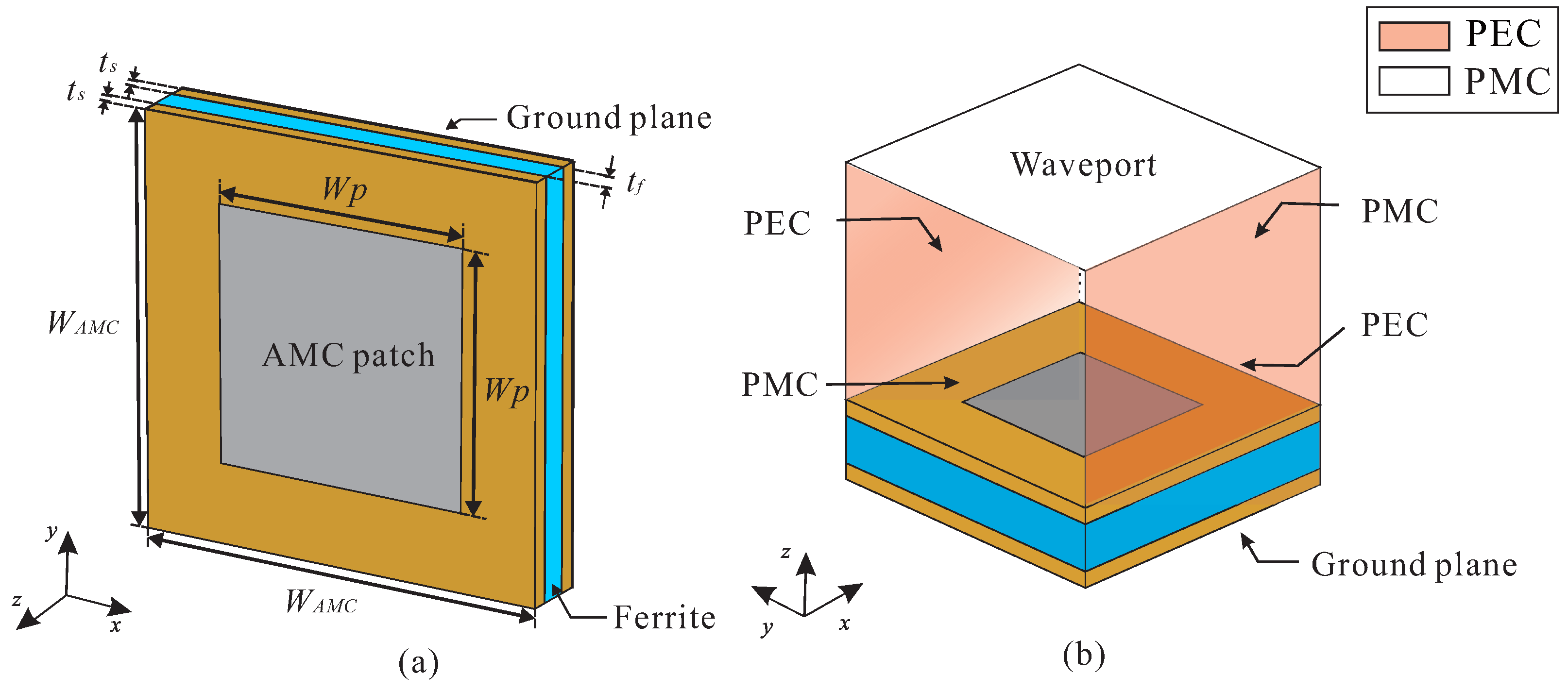
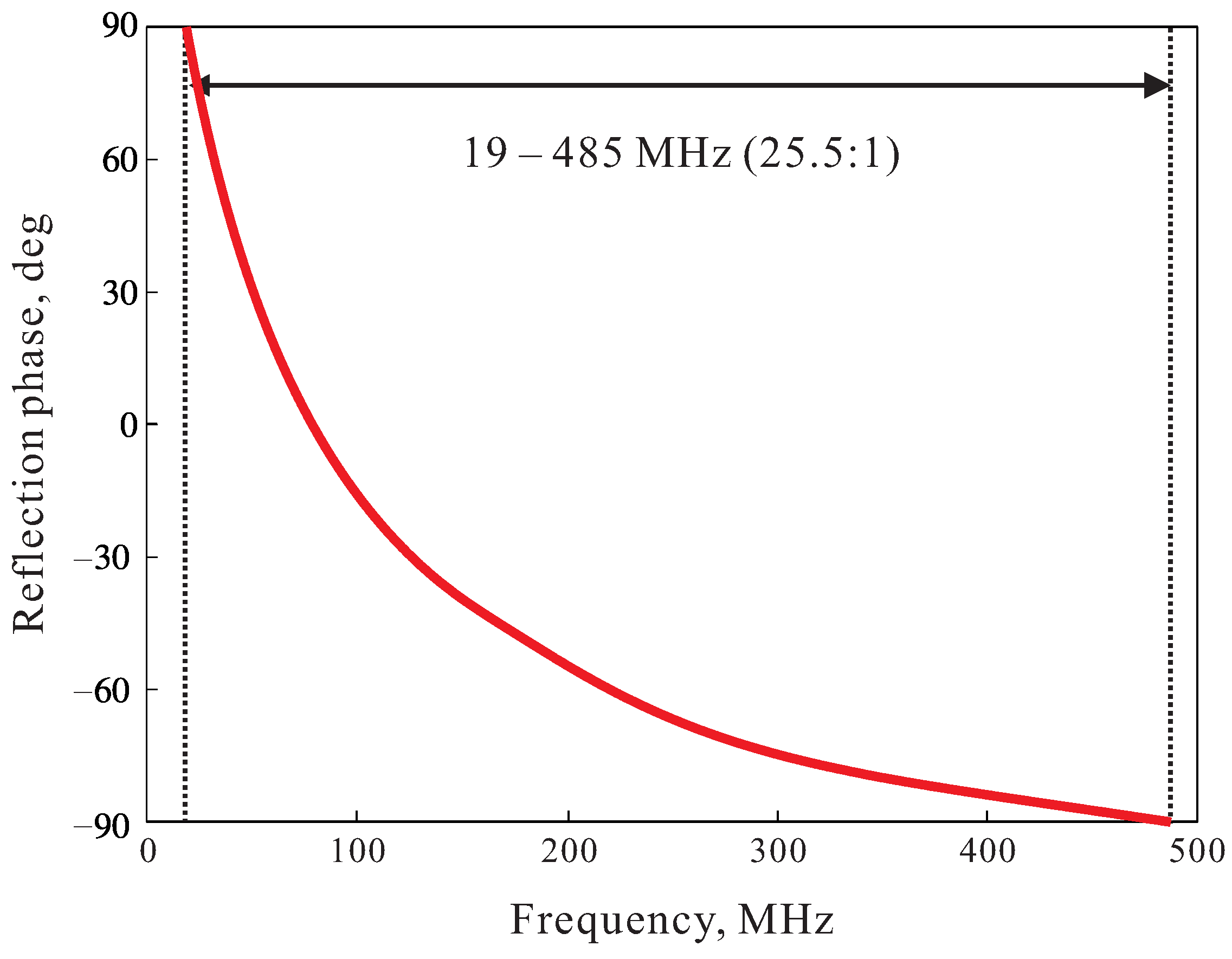
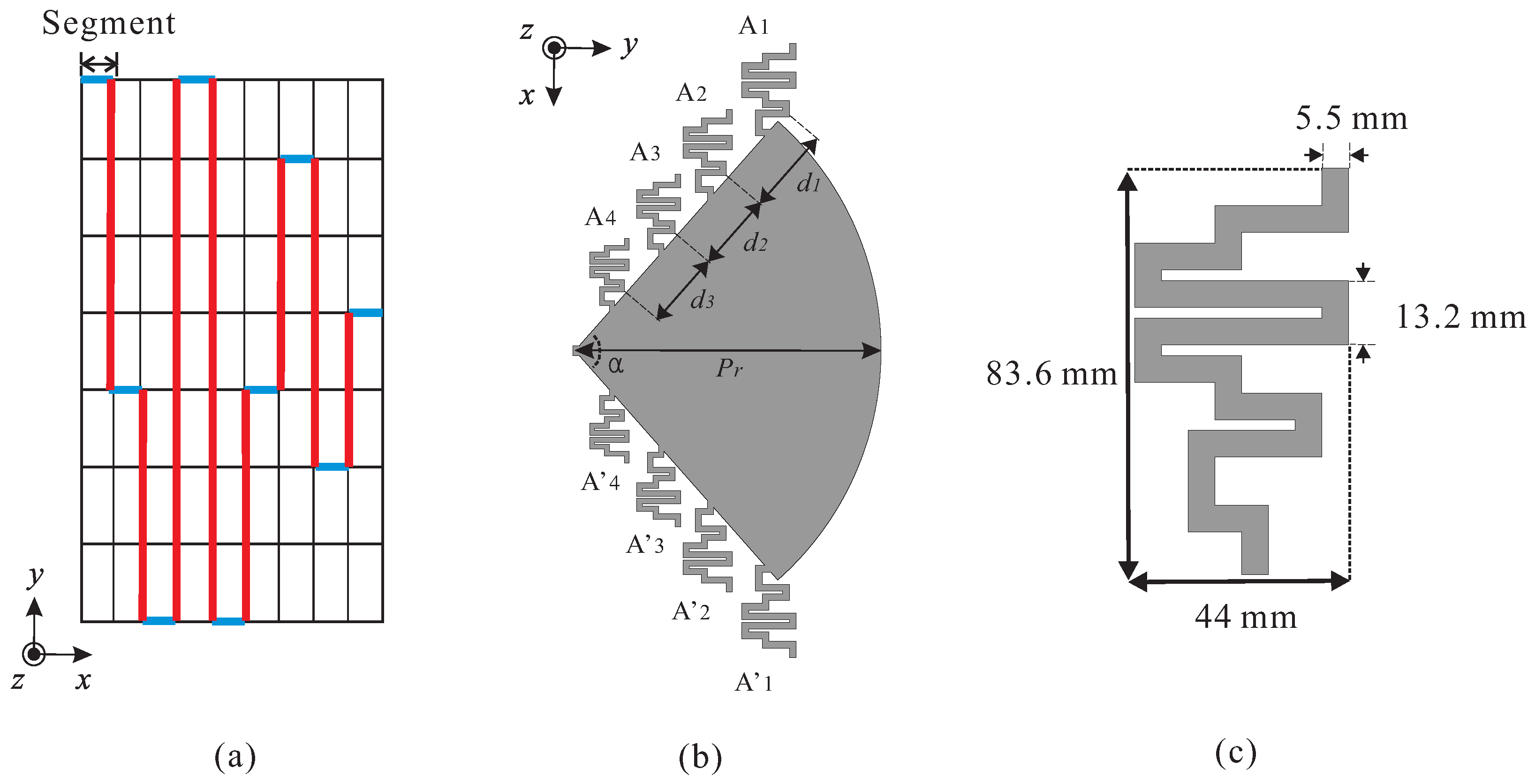

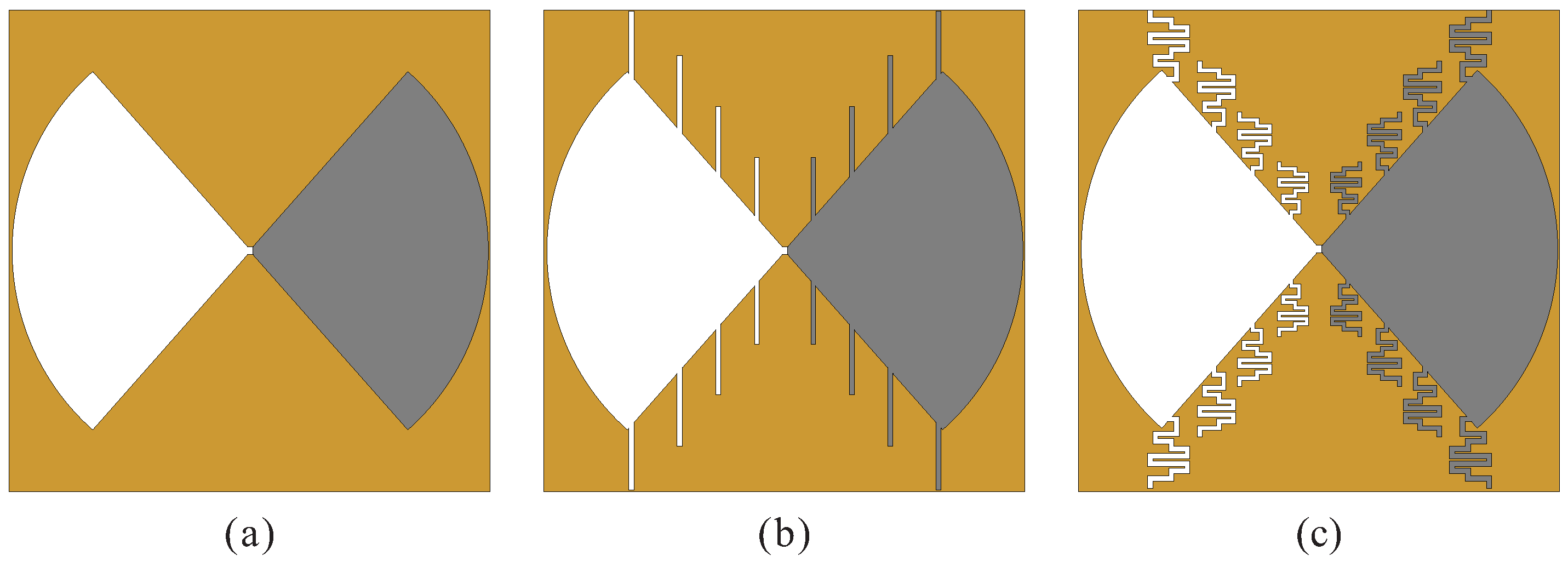
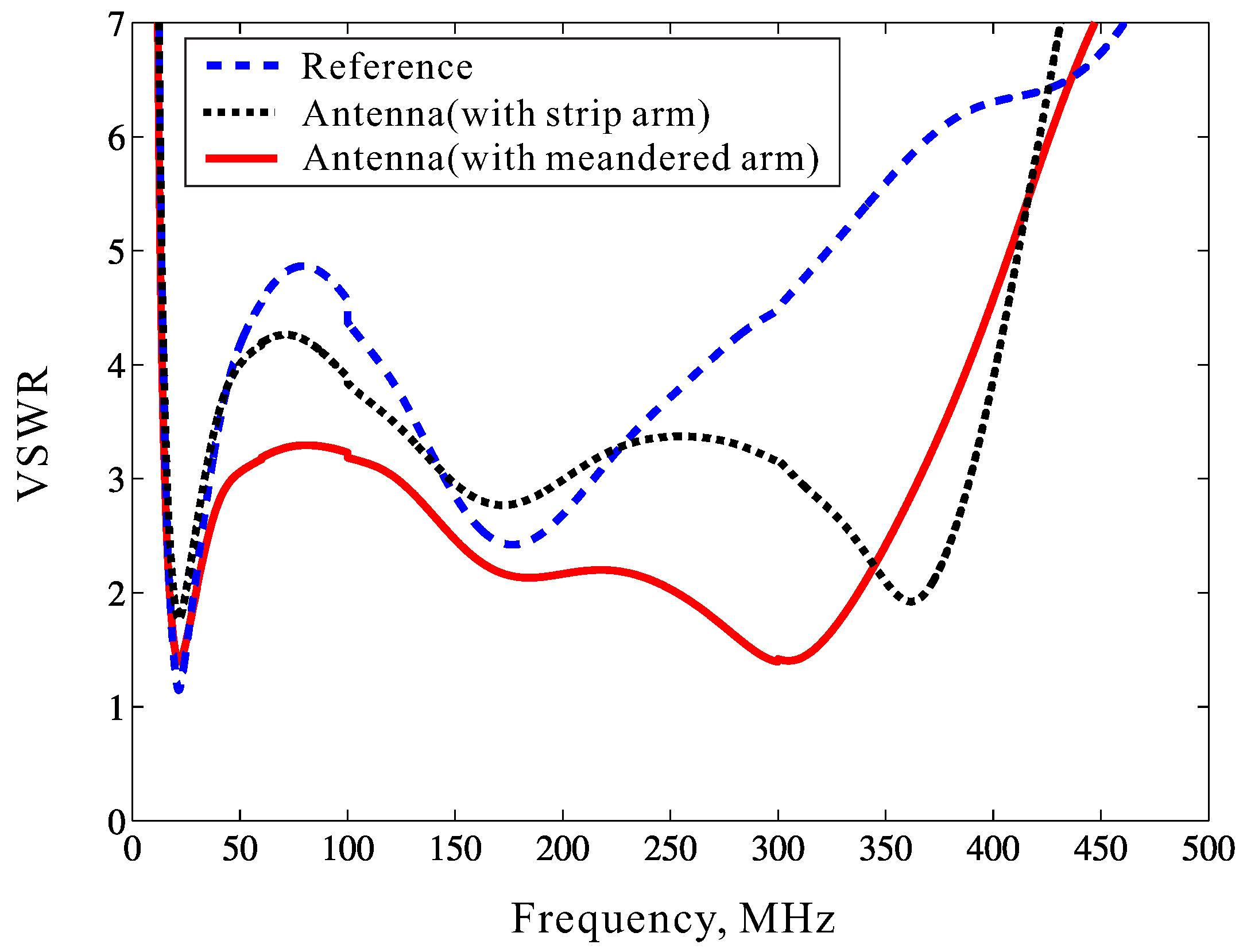
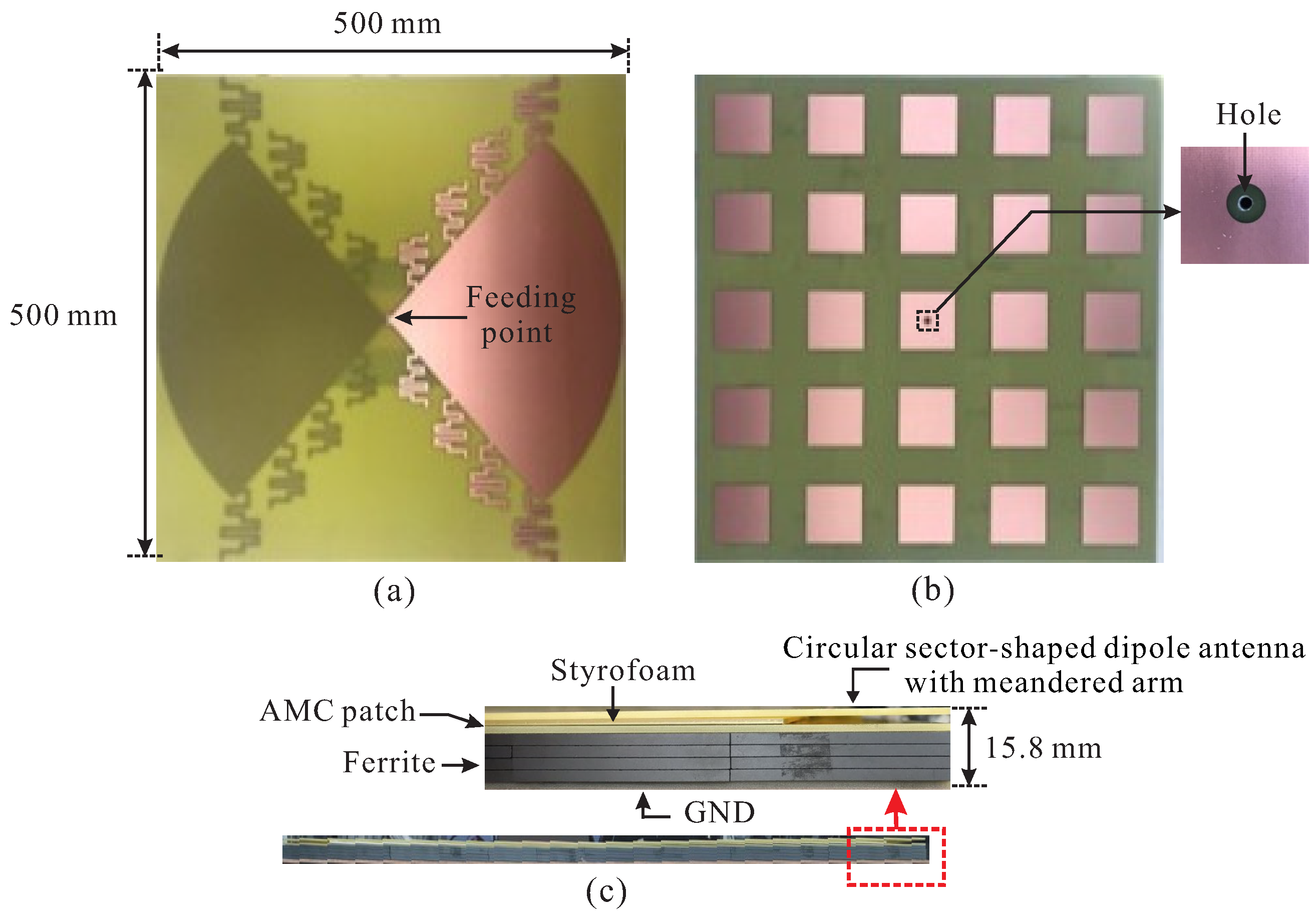
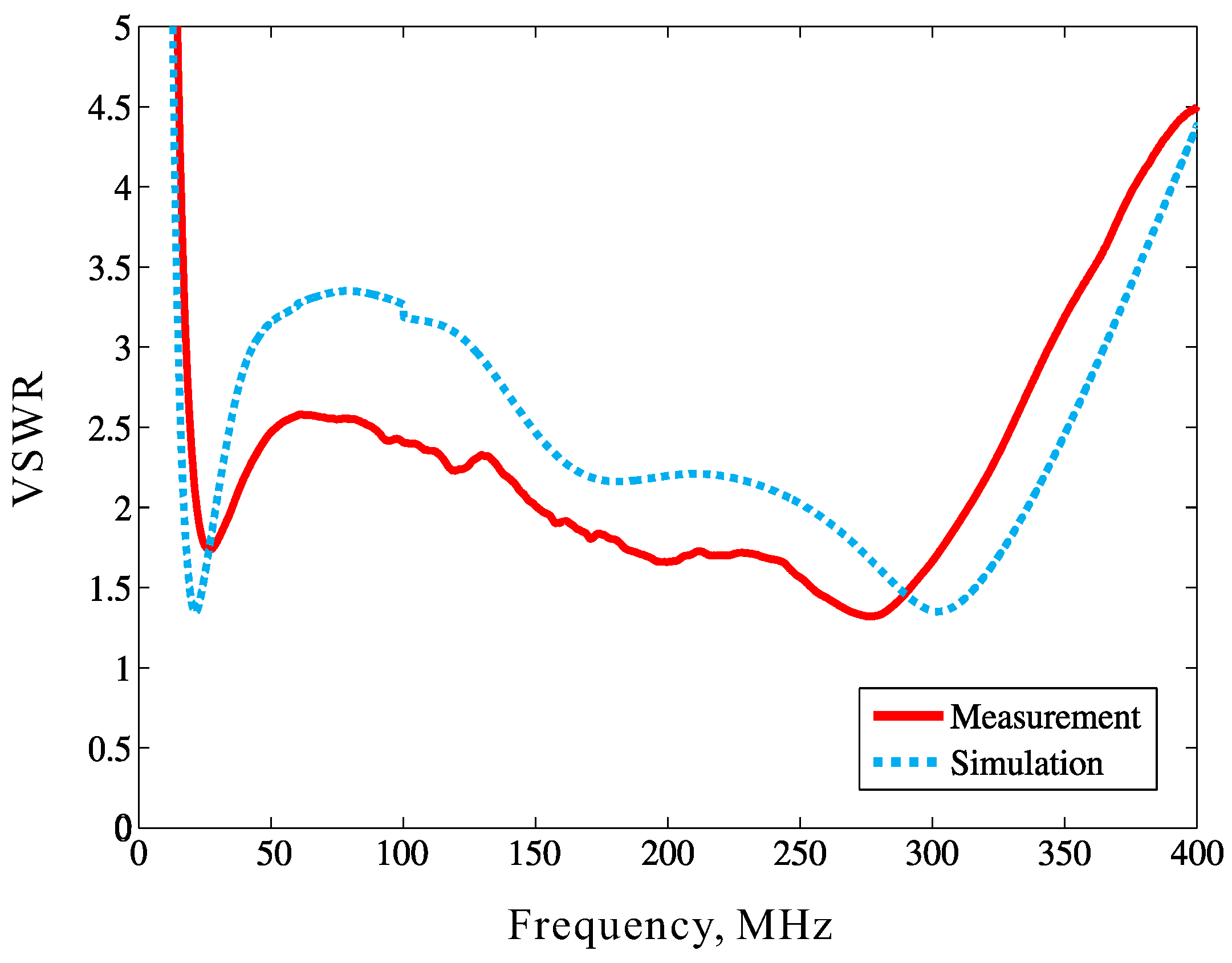
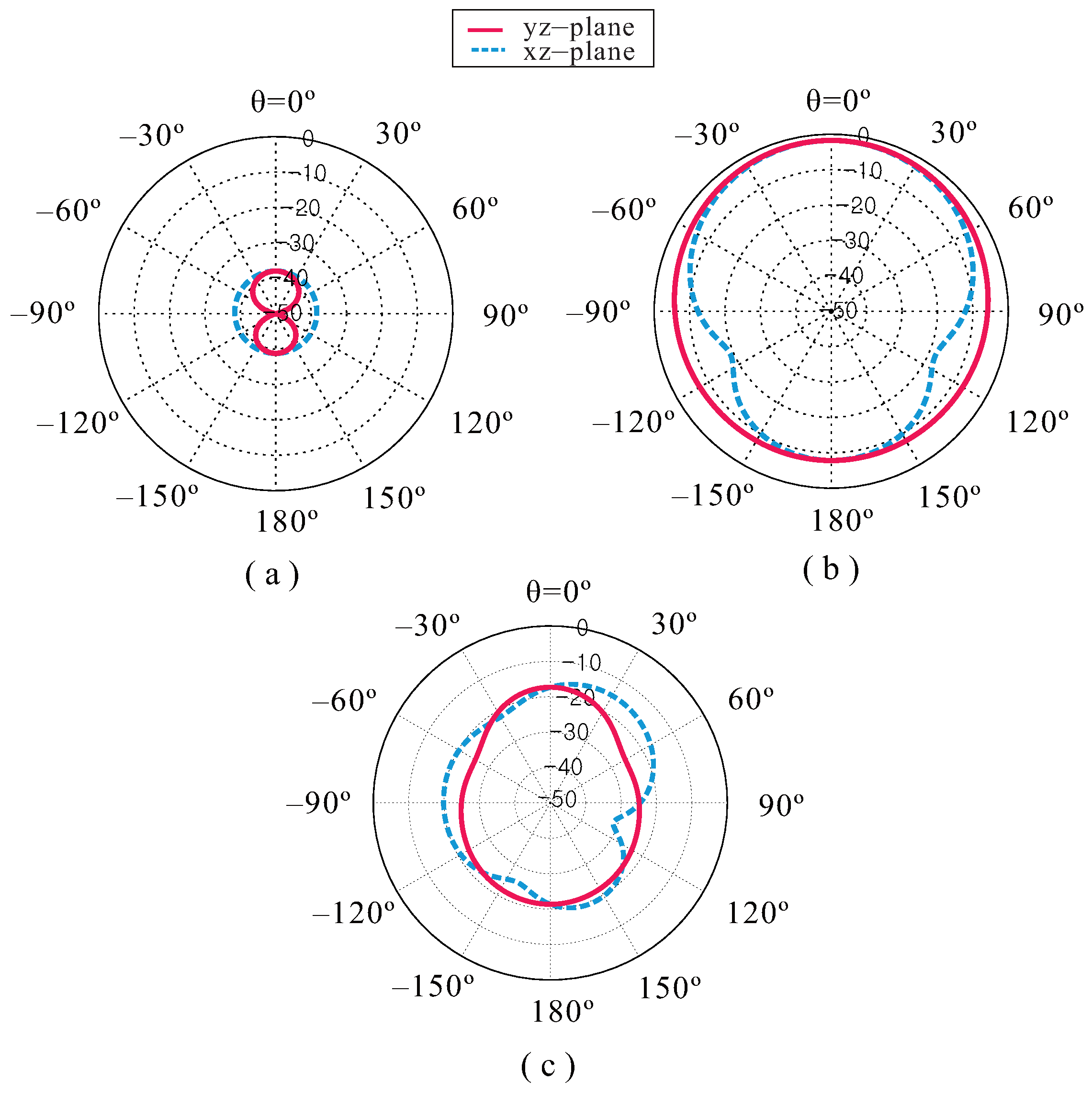
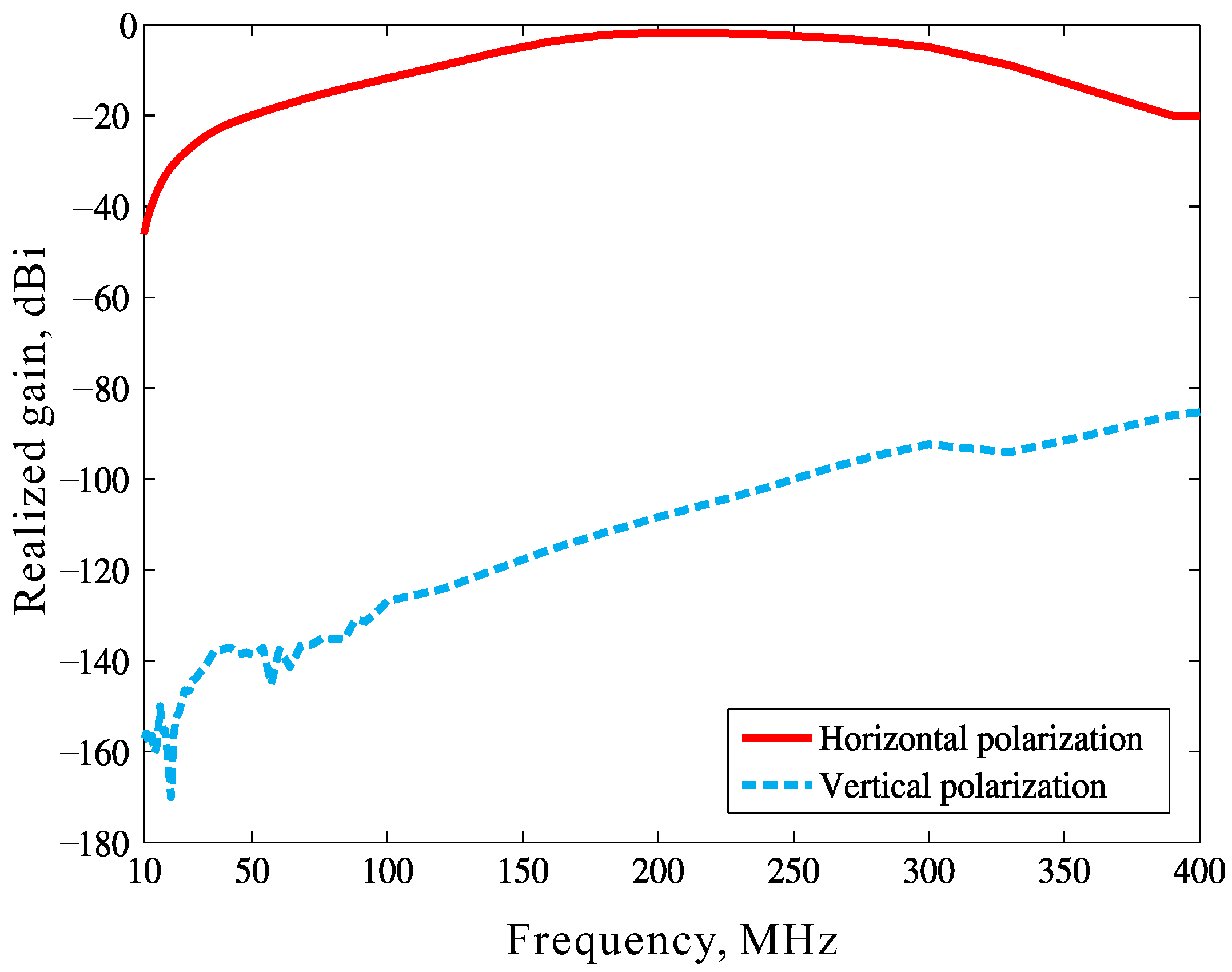

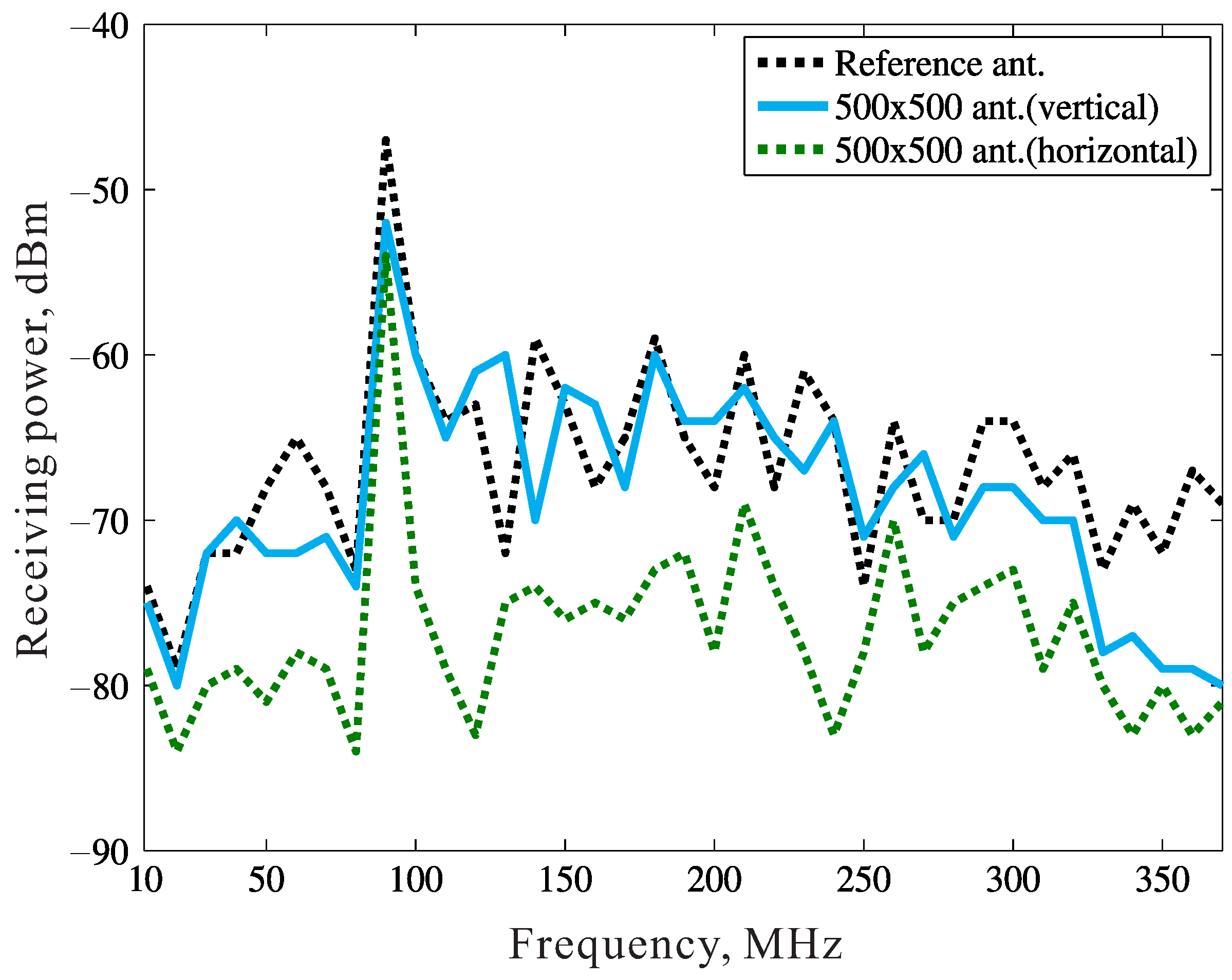
Publisher’s Note: MDPI stays neutral with regard to jurisdictional claims in published maps and institutional affiliations. |
© 2022 by the authors. Licensee MDPI, Basel, Switzerland. This article is an open access article distributed under the terms and conditions of the Creative Commons Attribution (CC BY) license (https://creativecommons.org/licenses/by/4.0/).
Share and Cite
Lee, D.H.; Kwon, O.H.; Park, W.B.; Hwang, K.C. A Circular Sector-Shaped Dipole Antenna with Meandered Arms and Added Ferrite-Loaded Artificial Magnetic Conductor. Appl. Sci. 2022, 12, 9149. https://doi.org/10.3390/app12189149
Lee DH, Kwon OH, Park WB, Hwang KC. A Circular Sector-Shaped Dipole Antenna with Meandered Arms and Added Ferrite-Loaded Artificial Magnetic Conductor. Applied Sciences. 2022; 12(18):9149. https://doi.org/10.3390/app12189149
Chicago/Turabian StyleLee, Dong Hwan, Oh Heon Kwon, Won Bin Park, and Keum Cheol Hwang. 2022. "A Circular Sector-Shaped Dipole Antenna with Meandered Arms and Added Ferrite-Loaded Artificial Magnetic Conductor" Applied Sciences 12, no. 18: 9149. https://doi.org/10.3390/app12189149





